The Hon. Bill Parry, (centre), was a keen shooter who seems to have driven legislation to revoke stoat/weasel/ferret and wild cat protection in 1936.
Photo credit - Auckland Library/NZ Herald
By John Dyer.
The New Zealand government, against the strongest protests from acclimatisation society shooting interests, not only allowed but actively encouraged the repeated import of literally thousands of stoats and weasels into this country from the UK between 1883 and 1892. As a harbinger of what was to come, the stoats and weasels sent on the first voyage consumed roughly 100 pigeons each, (NZ Herald 25/06/1888). As well as this the NZ government encouraged industrial-scale breeding and releasing of ferrets, all to control plagues of wild rabbits. The rabbits, along with gorse seeds, had ironically been previously privately imported by farmers who, “thought they would do well”. Even before the first of the stoats and weasels arrived it was declared by many that this supposed remedy would be worse than the disease. Thorough reviews have since confirmed these vermin completely failed to achieve the hoped for pest control results, but instead devastated our native wildlife. (King 2017). By 1905 the stoats released in the Wairarapa had already spread to Kaitaia in the Far North.
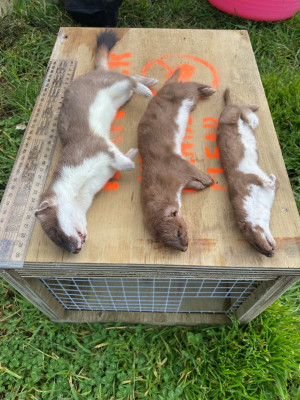
Photo: Left to right; a stoat with characteristic black-tipped tail, male weasel and smaller female weasel.
Governments have always been loath to admit mistakes, especially colossal ones, and it wasn’t until 1936 that they removed the strict legal protection they’d afforded these vermin. Ignoring the government’s threats to reimpose full legal protection again if they did so, acclimatisation societies immediately offered generous cash bounties on every stoat/weasel tail they received.
Legions of gamekeepers in the UK have waged war on stoats and weasels for centuries, (Jones 2014). Fortunately, a number of these keen observers living with nature also put their lifetime of acquired knowledge on paper. For those of us trying to control these same vermin introduced into NZ, this hard-earned gamekeeper knowledge remains as relevant today to anyone in this country trying to increase their tally of stoats, ferrets and weasels, (collectively known as mustelids), without having to reinvent the wheel.
For instance, just regularly disturbing the soil around any trap entrance can be a good lure all by itself. A Gamekeepers Notebook, written 1910, advises:
“Since rabbits supply the staple food of stoats they serve as bait. Anything that suggests newly done rabbit work is almost sure to attract the attention of a passing stoat. The keeper with his stick scratches up a little fresh soil in each visit to the trap to imitate what he calls “ferricking”, (meaning scratching), of a rabbit”.
Don’t be too quick to give that fresh stoat or weasel you just caught in your trap an “aerial burial” meaning don’t throw it away. He continues…
“During the mating season in the early spring, stoats are trapped most easily. When one has been caught it serves as a lure to attract others. The body is suspended just out of the reach of curious relatives and friends and a neatly hidden trap is set beneath it”.
In those days the “neatly hidden trap” would have been a gin-trap. However, gin traps were banned from use in England & Wales on 31st July 1958,
The first competition in the UK to find an alternative to the gin trap dates to 1874 when the naturalist Charles Darwin offered, through the RSPCA, a prize of £50 for an alternative humane device, (Haddon-Riddoch 2006). More competitions followed, all without finding a satisfactory gin trap replacement. That is, until 7 January, 1955, when an inventive ex-gamekeeper called Alan Arthur Fenn living in Redditch patented what was to become the humane successor to the doomed gin trap.
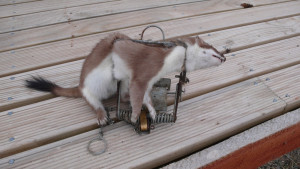
Photo: How the Mk4 Fenn trap works, (shown here removed from its’ tunnel).
Fenn eventually received an £850 prize in 1962 from the UK Ministry for Agriculture. His humane kill-trap commercially outlasted the other 4 traps selected for prizes from the total of 220 entries and it still remains in production today. The Fenn trap is set in tunnels, required by law in the UK to prevent accidental catches of other valued wildlife. However, I suspect from stoat catches I have made that this following trick first described in 1910 would work just as well with a Fenn or DoC trap.
“When the stoat, the mother of a family, is killed, her young do not fail to come to her. The apparent affection springs chiefly from desire for food. No food forthcoming, the young stoats quickly begin to devour their unfortunate mother. The gamekeeper knows that having once caught a mother stoat, he will have little difficulty in catching her family also; but having captured the family, it is by no means easy to secure the mother”.
For this reason, if you chance upon a pack of stoats, it is almost certainly a grown family foraging for food with their mother likely at the front. Be sure to shoot her first and there’s every chance you’ll catch the remaining kits with traps set below her body suspended on a convenient twig in bushes just above.
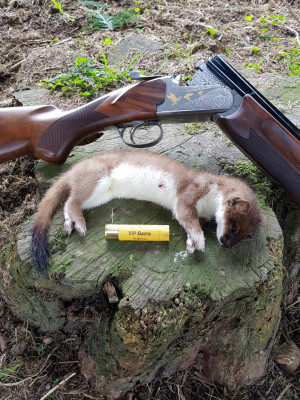
Photo: don’t spare the cartridge!
Stoats sometimes feed on weasels you’ve caught and by reusing them as bait and you may catch the stoat itself. Any other fresh kill in the trap is worth also considering. For instance, a fresh rat will often bring in a passing stoat and Fenn traps are usually set in pairs. Even just the smell of a fresh rat increases the chances of your trap catching a stoat while it’s out committing “gamecide”. The Control of Vermin, (1968), advises:
“When fresh baiting traps it is a wise move to scatter the old bait around. Neither stoat nor weasel will eat this old stuff, but the scent draws them to the spot and the fresh-baited trap entices them to their doom”.
‘Moorman’ in 1908 had more to say on baits:
“Something fresh-killed has far more attraction for (mustelids) than anything stale or putrid, so that anything in the shape of small birds or rabbit’s flesh or liver, not entrails, serves the purpose excellently”.
He refers to peeling back the dead birds’ skin, from the shoulder toward the head, to expose the neck and thus make the bait more enticing to mustelids. Archie Coates in 1978 further advises:
“I have noticed that when victims are hung up somewhere near at hand, a trap catches quicker after being reset… but do not hang them over the trap. If you do, the maggots fall out and prove irresistible to small birds, thrushes particularly, which go in after them”.
Stoats, of course, also steal eggs. However, the author of Ten Years of Gamekeeping, (1909), adds that 9 out of 10 of eggs found in stoat caches did not subsequently get eaten:
“Once an egg is broken, stoats relish the contents as keenly as do ferrets, yet while removing eggs they are most careful not to break them”.
“I believe the explanation of their not eating stolen eggs is that they cease to recognize them as fit for food after the scent of the siting bird has left them. I have recovered from the lairs of stoats lots of eggs in which incubation had not started, hatching them under fowls, and reared birds from all of them”.
What this suggests to me is that, getting carefully sterilized eggs from the supermarket may not be half as useful a lure as unwashed back-yard hen eggs still smelling of the chicken that laid them or the clucky bantam that had started sitting on them.
Frequently, I’ve been told in NZ of mustelids being caught by setting traps near the bodies of chickens or other victims they’ve just slain. Here’s what A Gamekeepers Notebook of 1909 has to say about this:
“The only bait which is a certain charm is something which the stoat has caught itself, from the enjoyment of which it has been newly disturbed. Should a gamekeepers’ coming drive a stoat to cover, he has only to wait in range for a few minutes to pull the avenging trigger”.
As an example of this, I noticed that a freshly killed possum in one of my kill traps seemed to have fresh feeding damage around its neck. I left its body on top of the Fenn trap tunnel and just minutes later heard the reset trap snap shut on the stoat that had returned to its’ feed.
A freshly dead rabbit with blood around the back of its’ neck is a mustelid at work. Don’t be afraid to drag a stoat’s kill into a better position for a clean shot when it returns. Rest assured it will not be far away. Ian Alcock wrote about bloodsucking stoats:
“(They) …throttle their prey rather than tearing out their throats or killing them outright, so that they can start eating the unconscious victim while the blood is still pumping, in order to drink the blood. On six occasions I had the unusual opportunity of watching a stoat kill a rabbit. In short, the stoat often took up to an hour “playing” with its victim before it was dead. What it was doing was shaking the rabbit about and drinking blood from the two bite holes at the back of the neck. On two of these occasions, it also ate out one eye while the rabbit was still alive. I was able to demonstrate to my wife the appearance of the blood with the corpse of one rabbit that I retrieved as soon as it was dead, having watched this performance from the house with a powerful telescope. By shaking it as the stoat had done, two drops of dark red blood appeared on its neck”. They do however, eat meat.
Presumably stoats treat our endangered wildlife in exactly the same way, which makes it somewhat ironic that DoC replaced their highly efficient Fenn traps because these occasionally fail to kill a stoat outright for up to a minute. In my opinion, that observation could be more related to setting the traps hard to begin with, because DoC took all the Fenn safeties off. Who wants to set any trap light like that?
The Control of Vermin 1968 adds:
“A frightened weasel almost invariably turns directly it reaches covert, (cover), in order to see the cause of its disturbance or fright; then is the moment to shoot – if the weasel has lived to reach cover. A stoat sometimes does so, but it will always sit up and make sure of any noise or disturbance puzzling it, unless it is badly frightened, so look out for the white waistcoat”.
In fact, if you hear the local blackbirds making their loud and distinct “tink-tink-tink” warning calls, grab a shotgun and sprint in that direction. There is almost certainly a predator such as a mustelid or feral cat lurking about. The Control of Vermin further states:
“These birds have a distinct note when disturbed. In nesting time, the bitch stoat, and it is the bitch-stoat that is of first importance, will spend hours climbing shrubs, young spruces, etc., looking for eggs and nestlings. The distracted birds will advertise the exact whereabouts of their enemy, so the man with a gun gets a chance he ought to clinch every time”.
In NZ, if introduced myna birds shriek in alarm, you can also be sure there is a predator about such as a feral cat. In their native India, many a snake’s presence near a village has been betrayed to humans by these myna bird commotions.
If you accidentally disturb a stoat, you can often “squeak it out”, (imitating a mouse), and back into view by audibly sucking against the web of your stretched hand between thumb and forefinger. I’ve done so myself, but I suggest you practise in advance.
Should you cover mustelid traps with fine sieved soil? ‘Moorman’ advises:
“Careful covering is time and trouble misspent… when trapping stoats, weasels” (and also polecats, a.k.a. ferrets).
He adds:
“The stoat is a very light-footed animal and all traps must be set very tickle”, (i.e. ready to spring), “to take them unfailingly. The springs must act quickly and sharply or you will miss your quarry time and again. All traps for them should be set before noon or they will not be effective the same day”.
Avoid using Fisholene which becomes hard with age and so it slows down trap mechanism, the exact opposite of what is required.
“The trap works while the keeper sleeps”, advised Archie Coates in 1962 and revised again 1978. He added that, “A trap should be kept in position for at least 2 or 3 weeks, and it takes 2 or 3 days for your smell to leave it when first set. Funnily enough, hedgehogs, (an inveterate egg-stealer), don’t seem to mind human scent”.
Archie added that:
“Hedgehogs are… inveterate egg-stealers and travel extraordinary distances in search of food”. (To catch them) “some keepers like to bury an old kipper”, (a cold-smoked herring, a small oily fish), “under their tunnel”.
I independently rediscovered Archie’s 2-3 day scent rule, (i.e. I reinvented the wheel), by numbering traps and keeping a log-book of each baiting and all catches, as indeed you should too. He further states:
“If a trap has not caught for some time, particularly in wet weather, it may be wise to reset it and use your onion-hoe to scrape out the tunnel”.
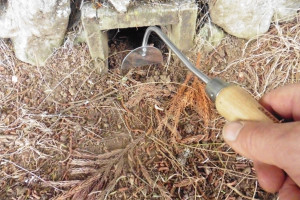
Photo: Onion hoe for tunnel maintenance.
Wet weather can clog the trap and tunnel with silt, leaves and so on. Springing the trap off outside the tunnel flicks this off. I obtained my Kent & Stowe swan-necked onion-hoe from Trade Me in NZ but Ebay-UK is another good source. It’s a most useful small hand-tool for housekeeping in and around wooden Fenn tunnels.
“Petrel” (Peter H. Whitaker), wrote in the Shooting Times in 1963…
“Shallow water in a drain is no disadvantage to effective trapping. Stoats love to run through such places and surprisingly are almost always bone dry when caught. The water, of course, is good camouflage for the trap”.
Older keepers never used gloves, but modern ones generally do. Whichever you choose, be sure that any strange smells like soap or tobacco are muted.
“The stoat has an inveterate hatred of tobacco”, states LCR Cameron who describes how to use a pipe half filled with strong tobacco to smoke out a stoat from a stone wall or similar retreat.
Michael Brander wrote:
“Before setting any traps the trapper should always rub his hands well with soil to dull the human scent. He should do the same with the traps themselves”.
Stuart Haddon-Riddoch told me that one successful British keeper always used cotton gloves; his secret, he never washed them - ever!
Dugald Macintyre in the Lonsdale Keeper’s Book of 1938 advises:
“New traps are not so good as old ones, partly because the “smithy” smell remains, and it is a good plan to bury them for a fortnight before use”.
By doing so, enzymes in the soil impart a natural smell to the traps and also dull their shine. You can also get rid of the factory-oil smell of any brand-new steel trap by first giving it a cycle in the dishwasher, while Mum’s out of course!
On trap care, ‘Moorman’ further stated in 1908:
When traps become rusted and dirty soak them in paraffin* to remove rust and then wash them thoroughly in hot water with plenty of washing soda** in it. Oil working parts with vegetable oil. Never employ mineral oil or animal oil or fats”.
(*Paraffin here refers to kerosine, which loosens rust. But soaking in cheap white vinegar will do a better job of rust removal).
(** washing soda crystals are available from supermarkets and Bin-Inn shops. Only simmer, NEVER boil steel traps as the latter significantly affects their spring strength).
Another trick with tunnel traps is to pull back the tail of a dog-stoat, (i.e. male stoat), you catch and rub its’ bottom, where its scent glands are, against the trap entrance roof. This territory marking compels other male stoats to investigate. Ulf, my German gamekeeper friend, once told me, “Imagine that you smell strange cigarette smoke coming from your wife’s bedroom. Would you hesitate to investigate?”.
If it is a female or bitch-stoat, squeeze her bladder over the plate of the trap to encourage every love-sick male stoat in the district to check it out. The Control of Vermin, 5th edition, advises:
“When a bitch stoat has been shot or captured the trapper possesses a treasure; he should make a point of visiting all his traps and pressing the slightest drop of urine on each. It is a potent lure… Many trappers assert that the urine of a bitch ferret in season is just as efficacious. The carcass of an old dam (female) stoat is always a sure bait”.
Michael Brander added:
“A female stoat or weasel trailed along a ditch will be certain to lead several males into a trap or traps sited there”.
Covering the tunnel in rocks, sticks, small logs and so on also increases catches as A Gamekeepers Notebook of 1909 describes:
“The keeper sets a tunnel trap, covering it with bundles of brushwood, and every stoat that comes along will explore so likely a lurking place for a rabbit, and each naturally enters by the fatal passage”.
Make sure that whatever covering you use to make the trap more inviting, that it does not require any significant amount of time to remove to check, empty and reset the trap. Multiplied by every trap visit, this soon becomes tedious. Hence why the keeper chose “bundles of brushwood”, not loose sticks. A cleared path to and from the trap tunnel entrances should look like a well-used animal run which will interest any passing mustelid. “A clean entry means a clean catch”.
Small baits such as rabbit or hare flesh or liver, which along with eggs remain very popular gamekeepers’ lures, have only a limited reach in terms of their plume of smell. You can ratchet this up by cutting open the gut of the rabbit and smearing it near the trap entrance on nearby rocks and up tree-trunks to get that message out further, (C. King, pers. comm.). Or blow one egg’s contents out and strew it about the immediate vicinity as a scent lure. You can also tie the rabbit carcass to some twine and drag it from trap to trap, so that anything that cuts this spoor will follow it to the next trap. If using meat baits, some fat on them lasts longer.
If you trap and kill a stoat, shoot or even come across a freshly run over one, drag it on a string through a field then turn your dog out to follow the scent and find it. Give them plenty of praise and a small food reward when they find this odd-smelling creature. After a few practises you might find they’re now fully switched on to finding stoats and their lairs in the wild. The latter will probably be littered with the remains of small birds and suchlike and is typically found under old sheets of iron, stacked fenceposts, branch piles and other dry spots. Be ready to shoot immediately you uncover it. It’s very unlikely a stoat will let itself be discovered like this twice.
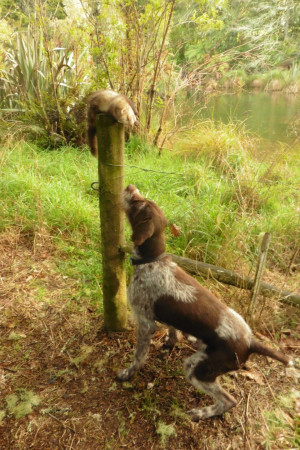
Photo: Mustelids smell odd to dogs, but with simple encouragement, they will readily seek them out.
In summary: If you’re an “amateur keeper” trying to improve your trapping prospects, don’t forget now to do your “ferricking” in front of each trap. Also, don’t be too quick to do the “aerial burial”. Set your traps ticklish and particularly before noon. I hope these comprehensive hints from the past will help increase your tally in the future. The benefit will certainly be more gamebirds and more native wildlife. And don’t forget to support the Hunting & Fishing “Swamp Comp” predator trapping competition to encourage more conservation-minded people just like yourself. Your chances of winning a very nice prize are hugely better than Lotto and the entry is entirely free.
Literature cited:
Alcock, Ian. 23/11/2000.
Bloodsucking stoats, (article).
Shooting Times and Country Magazine.
London.
Annon. (1968).
The Control of Vermin.
Gilbertson & Page Gamekeepers and Countryside Dept.
Hertford. Herts. UK.
Brander, Michael. 1965 (Reprinted 1971).
The Game Shot’s Vade Mecum.
Adam & Charles Black, London.
Cameron LCR. 1920, (reprint 2004).
Minor Field Sports.
George Routledge & Sons Ltd, London.
Carnegie, William, (‘Moorman’). 1908
How to Trap and Snare.
Shooting Times, London.
Coates, Archie 1962 & revised 1978.
The Amateur Keeper, a Handbook for the Small Shoot.
Andre Deutsch, London.
Haddon-Riddoch, Stuart (2006).
Rural Reflections: a Brief History of Traps, Trap-makers and Gamekeeping in Britain.
Argyll Publishing, Glendaruel, Scotland.
King, Carolyn M. 2017
Pandora’s Box down-under: origins and number of mustelids transplanted to New Zealand for biological control of rabbits.
In Biological Invasions.
Springer International, Switzerland.
Jones, David S.D. (2014).
Gamekeeping, an Illustrated History.
Quiller Publishing, Shrewsbury, UK.
Jones, Owen (1910)
Ten Years of Game-Keeping.
Edward Arnold, London.
Jones, Owen and Marcus Woodward (1909).
A Gamekeepers Notebook.
Edward Arnold, London.
Mackie, P. Jeffrey – Editor. 1910.
A Keepers Book: a Guide to the Duties of a Gamekeeper.
T.N. Foulis, London and Edinburgh.
Parker, Eric, (Editor). 1938 edition.
The Lonsdale Keeper’s Book.
Seeley Service & Co, London.
“Petrel”, (Peter Whitaker), 19 April, 1963.
Trapping Time.
Shooting Times & Country Magazine.